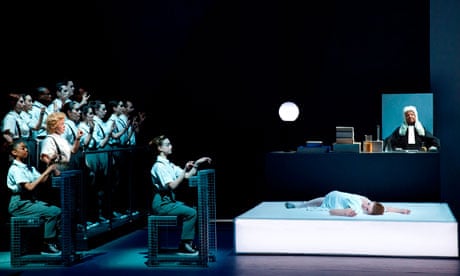Philip Glass's list of stage works stretches well beyond 20. The majority have reached Britain, but until now Einstein on the Beach – the work he devised in 1976 with director Robert Wilson, launching his career as an opera composer and making his name internationally – had never been seen here. The belated UK premiere of Einstein harks right back to that beginning: it's Wilson's re-creation of the original five-hour production.
That, though, is both a strength and a shortcoming of the revival. Glass's Einstein score does allow for the possibility of other directors creating their own stage images inspired by the life of the great physicist, but the music is so bound up with Wilson's visual concept and is largely so subservient to it that to place the score in any other theatrical context would seem very strange.
Einstein on the Beach began a trilogy of Glass's operas, each of which centres on a different historical figure. But for all their originality, not only are Satyagraha (about Gandhi's life and teaching) and Akhnaten (about the Egyptian pharaoh) much more conventionally operatic than Einstein, they are far less abstract, too; you won't learn much about Albert Einstein or his theories from an evening in the Barbican, except that he loved toy trains as a child and played the violin, and that his theories had something to do with the destructive power of nuclear explosions.
When Einstein was first performed, nobody had seen anything like it; the idea of an abstract opera, in which the music underpinned a series of slowly moving stage pictures was entirely new. But for all its historical importance, it seems rather old-fashioned now, and at times the experience was like watching the theatrical equivalent of a period performance, as if achieving the same results using today's technology would lose something essential. Many of the images in Wilson's tableaux would nowadays be conjured using video or computer-generated graphics rather than with smudgy slide projections, painted flats and cardboard cut-outs; it would all seem slicker, less contrived.
Somehow, too, Wilson's abstract inventions have lost a lot of their visual magic: a narrow rectangle of light slowly rotating from the horizontal to the vertical to the accompaniment of Glass's churning patterns isn't quite the iconic image it once was. On the opening night, as well, backstage technical problems added to that sense of dated clunkiness. The performance began half an hour late, and an unscheduled interval had to be inserted after the first act, when one tower refused to move on and off stage as expected. Wilson himself then appeared to explain the problems and to announce that the final scene would not include the flying figures it should.
But if the mechanics creak, the performances certainly have the kind of commitment, unflagging concentration and energy on which such projects depend. The dancers executing Lucinda Childs' choreography seem tireless; the vocalists have Glass's endless melodic tropes entirely by memory; the actors are faultless in their delivery of texts whose essence is convolution and repetition. The ensemble under Glass stalwart Michael Riesman gives the score verve and drive and just occasionally, when all the visual and musical elements fuse into a unity, as they do in the final scene, the real originality and power of Glass and Wilson's concept comes across.

Comments (…)
Sign in or create your Guardian account to join the discussion